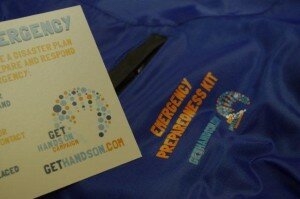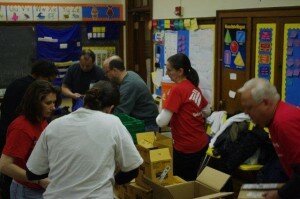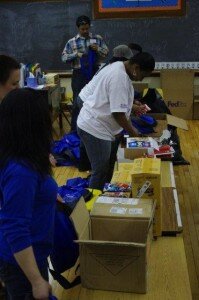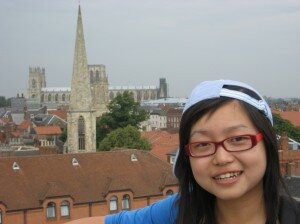 Today’s post comes from Claire Dooms, a Get HandsOn AmeriCorps member at Chicago Cares.
Today’s post comes from Claire Dooms, a Get HandsOn AmeriCorps member at Chicago Cares.
Whether the threat is fire or flood, it’s good to be prepared. Here are a few essential components to a solid disaster preparedness plan:
- Have a family communication plan. If a disaster strikes, it’s helpful to have a plan for contacting loved ones with updates.
- Create an emergency supply kit. If there’s a chance you’ll be without power or access to food and water, it’s best to have a stock of non-perishables on hand.
- Have a place to go. If your current living situation becomes inaccessible or too dangerous to return to, you should have an alternate place to stay.
- Secure your home. By making your home somewhat “disaster-friendly,” you’ll be better able to save the things that are most important to you, as well as save on damage costs.
- Have a pet plan. Like it or not, our furry friends are often among the first things we concern ourselves with – don’t leave your pet behind!
 When natural disasters strike, it’s amazing how a community, a country, even the world, can come together in light of a tragedy.
When natural disasters strike, it’s amazing how a community, a country, even the world, can come together in light of a tragedy.
Sometimes it’s hard to feel like there’s a way to really make a difference, but we all feel that urge to help. While we might not be able to help strangers with family communication plans, or finding an alternate place to go, we can help stock them with the emergency supplies they need until more comprehensive assistance becomes available.
 On Tuesday, April 19 a group of volunteers got together to do just that.
On Tuesday, April 19 a group of volunteers got together to do just that.
As part of HandsOn Network’s Road to the Gulf campaign, volunteers packed individual disaster preparedness kits to send to the Gulf Coast. The campaign is an effort to accomplish a few things, one of which being to raise awareness and support for our neighbors in need. But, the focus is also local, with the intent of training Volunteer Leaders to initiate their own projects and build service capacity.
Leading the disaster kit packing project, I was amazed at how quickly my group of volunteers flew through everything! In what seemed like no time, we packed five hundred bags!
 It was very rewarding to see everyone working together and working out a plan to get things done. Once we finished, I was more than happy to answer their questions about exactly what the purpose of the bags was and how they could get more involved in service work in their own communities.
It was very rewarding to see everyone working together and working out a plan to get things done. Once we finished, I was more than happy to answer their questions about exactly what the purpose of the bags was and how they could get more involved in service work in their own communities.
It was a great time with a lot of fun volunteers, and while the weather was damp, our spirits were not. Thanks HandsOn, for helping make the best of a rainy day!
Claire is currently a Get HandsOn AmeriCorps Member at Chicago Cares. When she’s not working on volunteer programs, Claire likes to bike and do anything outside. She’ll complete her first century ride in August!

 Today’s post comes from Jie, Marcomm Manager with
Today’s post comes from Jie, Marcomm Manager with  Volunteers helped to teach and train the students at Shanghai Migrant School by giving them the opportunity to grow in character and develop important sports skills. Elyn, the project coordinator, was very thankful for all their help. She said, “Volunteers always help us to improve the quality of the children’s education. Without them, we would be nothing.”
Volunteers helped to teach and train the students at Shanghai Migrant School by giving them the opportunity to grow in character and develop important sports skills. Elyn, the project coordinator, was very thankful for all their help. She said, “Volunteers always help us to improve the quality of the children’s education. Without them, we would be nothing.” The project was a success. Although it was raining earlier that afternoon, three volunteers delivered a fun class for all twenty students. They taught the rules of the sport, they played team-building games, and finished the afternoon with a game of basketball. The enjoyable and playful atmosphere was obvious during the whole process. The close bonding between students and volunteers was simply showed through their gestures and conversations.
The project was a success. Although it was raining earlier that afternoon, three volunteers delivered a fun class for all twenty students. They taught the rules of the sport, they played team-building games, and finished the afternoon with a game of basketball. The enjoyable and playful atmosphere was obvious during the whole process. The close bonding between students and volunteers was simply showed through their gestures and conversations. Know what you’re looking for.
Know what you’re looking for. HandsOn Network, the volunteer activation arm of
HandsOn Network, the volunteer activation arm of  Today’s post comes from Francis Paulino at
Today’s post comes from Francis Paulino at  While one student stood up front writing words on the board, the others helped out the Sunshine Home residents with their pronunciation. The student up front would write and say “boat, b-o-a-t, boat!” and the residents would cheerfully repeat their newly learned word in English.
While one student stood up front writing words on the board, the others helped out the Sunshine Home residents with their pronunciation. The student up front would write and say “boat, b-o-a-t, boat!” and the residents would cheerfully repeat their newly learned word in English. One of the residents even sang a song in English! And out of all songs he could have known I was surprised with his choice when I heard the words to John Denver’s “Country Roads”! Some of the volunteers from Shanghai Institute of Foreign Trade also shared their beautiful voices by singing tunes by Michael Jackson that everybody knew. Overall, the atmosphere was one of celebration and everyone had a great time!
One of the residents even sang a song in English! And out of all songs he could have known I was surprised with his choice when I heard the words to John Denver’s “Country Roads”! Some of the volunteers from Shanghai Institute of Foreign Trade also shared their beautiful voices by singing tunes by Michael Jackson that everybody knew. Overall, the atmosphere was one of celebration and everyone had a great time! For the last thing on the list, the volunteers planned for everyone to play the game called the “Human Knot”. By then everyone felt comfortable enough to holds hands and tie each other in a knot by going in between people without letting go of your neighbor’s hands. After getting twisted into a knot, everyone had to work together as team to untangle themselves, which was received with cheers, claps and a feeling of accomplishment when the task of getting untangled was finally accomplished.
For the last thing on the list, the volunteers planned for everyone to play the game called the “Human Knot”. By then everyone felt comfortable enough to holds hands and tie each other in a knot by going in between people without letting go of your neighbor’s hands. After getting twisted into a knot, everyone had to work together as team to untangle themselves, which was received with cheers, claps and a feeling of accomplishment when the task of getting untangled was finally accomplished.
 Start the project off easy. Try to set up the project in a way that’s easy to understand for your younger volunteers. Take some time to bring them all together to talk about what you’re going to do that day and why you’re planning on doing it. If there’s enough time built into your project, try taking the time to read The Lorax with your volunteers.
Start the project off easy. Try to set up the project in a way that’s easy to understand for your younger volunteers. Take some time to bring them all together to talk about what you’re going to do that day and why you’re planning on doing it. If there’s enough time built into your project, try taking the time to read The Lorax with your volunteers.


 Be sure to explain the impact of the project. Whether you’ve got a project planned to pick up litter in a park, plant trees in your community, or transplanting native grasses to help reduce sand dune migration, take the time to explain the impact of the project. It will help volunteers understand that the work that they’re doing has an impact outside of the work they’ve done that day.
Be sure to explain the impact of the project. Whether you’ve got a project planned to pick up litter in a park, plant trees in your community, or transplanting native grasses to help reduce sand dune migration, take the time to explain the impact of the project. It will help volunteers understand that the work that they’re doing has an impact outside of the work they’ve done that day. This post comes from Joanne E. Cohen, M.A., Organizational Consultant, CTAT at
This post comes from Joanne E. Cohen, M.A., Organizational Consultant, CTAT at 
